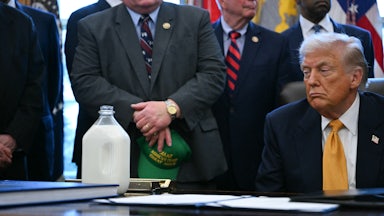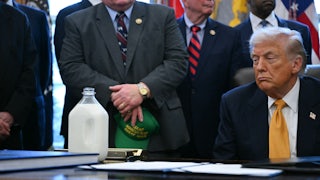For me and for most of my friends—and I’m guessing for you—the Trump presidency was daily hell for four years. Four years and more, really. For me, it started around 8:30 on election night 2016, when NBC changed some calls (notably North Carolina) that made it clear that there was a wave of Trump voters the polling didn’t catch, and he was going to win. The pain and outrage never let up until shortly before noon on January 20, 2021, when it finally became apparent that Trump would in fact recede peacefully back into private life.
That was life inside my bubble. And that was life inside the bubbles of virtually all loyal Democrats and/or committed members of the broad left for those four-plus years. The mere idea that this sociopath could be the president of the United States was inconceivably poisonous. That he was dangerous, unqualified, embarrassing, and un-American was a given. These were points that didn’t even have to be debated.
Outside our bubble, though, things looked different. I’m not talking about MAGA America. Those folks, we know all about. I’m talking about the people in between. They’re the people who’ll decide this election. And this election year, those of us inside our bubble need to go put our heads inside theirs. Because where they live, incredible as this may seem to you and me, the Trump years were good, and he was a pretty capable president. If all of us—especially Team Biden, obviously, but all of us—don’t take some time to understand and unpack this, Trump will win again.
Last week, NBC produced a poll showing that respondents were remembering the Trump years comparatively fondly. No, don’t roll your eyes and tongue-cluck these people. It’s vital that we ponder this.
Respondents were asked of Biden and Trump whether each man had done about the kind of job they expected, a better job, or a worse job. For Biden, the numbers were 14 percent better, 44 percent as expected, and 42 percent worse.
For Trump? Prepare yourself. It was 40 percent better, 31 percent as expected, and 29 percent worse.
Naturally, there are two big rationalizations to be made here. The first is that people’s memories are short in politics, and they mostly respond to what’s happening around them right now. The second is that a lot of people’s expectations for Trump were probably lower than they were for the experienced Biden.
Whatever. The numbers are the numbers. So why would people carry a fond memory of a presidential term that many of us consider to have been far and away the worst in American history?
Because the economy dominates people’s thoughts along these lines, and until the pandemic, the economy under Trump was pretty good, at least in the ways we measure these things. Let’s start with the most basic measure: jobs. In Barack Obama’s last two years, about 5.18 million jobs were created, according to these Bureau of Labor Statistics numbers. In Trump’s first two years, that number was about 4.51 million. Not as good, but still very good in historical terms, and certainly not the disaster liberals were warning about.
Pre-pandemic gross domestic product growth under Trump was also good—not the crazy 5, 6 percent he bragged about as a candidate, but in the 2.2–3.0 range. Trump’s 2.5 average in his first three years bested Obama’s 2.2 post-meltdown average (i.e., if we’re not counting the pandemic against Trump here, then we also shouldn’t count the great meltdown against Obama).
The stock market? It did well in Obama’s last three years, climbing from 16,458 to 19,827 on the day Trump was inaugurated. But in Trump’s first three years, it went from that number all the way up to 29,348 in January 2020, before the pandemic.
One more statistic: the median household income number in 2019. Median household income rose steadily during the Obama years after the meltdown. A thousand here, three thousand there. That’s how it usually goes, historically. But from 2018 to 2019, median household income jumped from $63,100 to $68,700—the biggest single-year increase going back 30-plus years. And more than that: It rose more in the lowest quintile than in the highest. A lot more.
Now don’t think I’m singing Donald Trump’s praises here. I am not. First of all, I should point out that our measures of economic success ignore the fact that we’ve transferred trillions of dollars of wealth from the middle class to the rich in the last four decades. We just accept this inequality as a given. We shouldn’t. This is what Bidenomics is changing—a transfer of some of that wealth back to the middle. Which is why rich people hate it so much.
Second, I think Trump inherited a strong and rising economy from Obama and mostly didn’t screw it up. He benefited from wage growth finally catching up to job growth in 2018 and 2019. He and the Republican Congress passed one bill, that big tax cut. It did have modest impact on increasing demand, since it put money in people’s pockets, but as usual with Republican tax cuts, most of its benefits went to the rich, and it increased the deficit.
In addition, that 2019 increase that the lowest quintile benefited from had little or nothing to do with Trump. It was the product, economist Dean Baker told me over the weekend, of the tight labor market. “When you have a tight labor market, it disproportionately benefits those at the bottom,” Baker explained. “The people who face discrimination or otherwise have difficulty getting hired get jobs when employers have no other choice. They also are in a position to get pay increases.”
But whatever the reason, it happened under Trump’s watch. Of course, so did the pandemic, which more than wiped out all these gains. Trump’s overall job growth number was negative, and he’s the only president in modern history of whom that can be said. (You can see here, by the way, that Democratic administrations have utterly crushed Republican ones in terms of job creation.) The stock market plummeted. The deficit went bananas. And so on. If you just look at the final numbers, Trump’s economic record is the worst in postwar America.
But there’s a real question as to whether swing voters blame him for that. Many of them would say the pandemic was not Trump’s fault. And it wasn’t. But the way he handled it was his fault. Remember how, very early on, he refused to invoke the Defense Production Act to spur manufacture of ventilators and personal protective equipment (he finally did, but only after the World Health Organization had declared the pandemic). He lied to the country about the virus’s severity, as Bob Woodward told us. One early 2021 study found that Trump’s policies or lack of them was responsible for 40 percent of pandemic deaths—which today number 1.2 million, by the way, and we still lead the world by far. Laurie Garrett, the country’s leading public health journalist, accused Trump of “pandemicide.”
That’s the kind of stuff highly informed voters may know. But those aren’t the voters I’m talking about it. Your average swing voters, if they ever knew this stuff, have long since forgotten it and have probably settled on the view that Trump was doing pretty well and the pandemic wasn’t his fault and he did what he could. Many, in fact, may credit him for presiding over the creation of lifesaving vaccines, and that’s fair enough: Operation Warp Speed kicked off under his watch.
There’s one final uncomfortable reality that we have to come to terms with, which is that for these voters, Donald Trump is not a moral monster. He’s just not. He’s embarrassing. He’s a little wild with his rhetoric at times. They wouldn’t necessarily want their sons to be like him. But they think he ran the country pretty well. It may be hard to believe, but this opinion is widely shared. Go read the story describing the results of that NBC poll I linked to above.
This is the one big point about Trump’s presidency, and perceptions of it, that the Biden campaign needs to understand. The voters who are going to decide this election think Trump wasn’t so bad. They may even think he was pretty good.
So what is there to do about it?
It is simultaneously true that those voters don’t like Trump. But they forget the specific things they don’t like. Here it is important to remind them. Remind them of everything. Not the things that offend liberals, like his racism and sexism. It’s fine to sprinkle some of that in there, but don’t assume these people share our values and will be as offended by all that as we are. They won’t be. Remind them instead of Trump’s idiocy. Buying Greenland. Sharpie-ing up that hurricane map. Getting the Boy Scouts—the Boy Scouts!—to boo Obama and talking to them about rich people having sex on yachts. Advising that people inject Clorox. Tossing paper towels to hurricane victims. And so on and so on.
Remind them of just how relentlessly he was in our faces, every hour of every day. It was exhausting. Your average person surely doesn’t want that. And remind them of his betrayals of normal American values. His love of Vladimir Putin. His disparaging of the military. Even more, his disparaging of service members and veterans. That John Kelly story. Kelly has confirmed all that now, on the record. MAGA people may not care that Trump thinks people who gave their lives for their country in battle are losers. But surely independent voters in the Milwaukee suburbs do—or will, if someone reminds them, and reminds them, and reminds them.
By the way: I think also that these voters can be made to care about democracy being at risk. Fascism may be an abstraction to them. But January 6 was no abstraction. They saw it. They understood what it was. They don’t approve. Democracy can and must be part of the argument to swing voters.
And it can swing voters. In NBC News’ Ryan Reilly’s book, Sedition Hunters, about the ordinary people who came together to help authorities identify the people who stormed the Capitol on January 6, the person who developed the app that the online sleuths used to share their work with one another actually voted for Trump—twice. As one of his fellow sedition hunters quipped, “There are moments in your life that you never forget where you are when they happened. September 11. Michael Jackson dying. Finding out Alex voted for Trump in 2020.” It goes to show that there are limits—even for people who approved enough of what Trump did in office to vote to reelect him.
My salient point is this: Those of us who have resided in our bubble need to take stock of all of our shared presumptions about Trump and remember that these voters—again, the ones who will decide this election—don’t share any of those presumptions. Right now, they remember that the economy was doing pretty well under Trump, and they’ve forgotten all the bad stuff. The Democrats have to turn those memories around by November, and the first step toward doing so is realizing that these voters don’t remotely see Trump in the wholly negative terms that we do.










